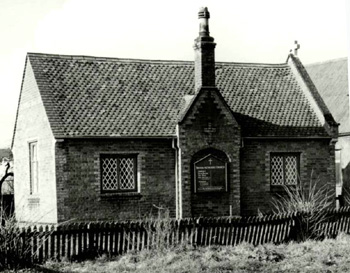
Broom School about 1900 [Z1306/106]
The first trace of Broom National Infants' School, which was at the southern end of the High Street, is in a Directory of 1864, the first direct archive of the school being a logbook [SDSouthill(Broom)1/1] of 1893. The fact that the school was a National School indicates that it was affiliated to the National Society, a body committed to educating poor children in the principles of the Church of England as well as the more secular aspects of education such as reading, writing and arithmetic.
A land mark Education Act was passed in 1902, coming into effect in 1903. It gave day to day running of education to newly formed Local Education Authorities, usually the county council, as in Bedfordshire. The old National, British and other non-Board schools became known as Public Elementary Schools. Broom, as a National School, became a Public Elementary School.
Bedfordshire & Luton Archives & Records Service has a scrapbook of cuttings of visits made to most Bedfordshire Schools by School Inspectors for a period from just before the First World War through the inter-war years [E/IN1/1]. The first report in the scrapbook dates to 1910, when average attendance was 29: "The premises have been greatly improved by the removal of the gallery, and by the new heating arrangements. The schoolroom is bright, well-warmed and well-kept. Order and tone are very good and the level of attainments reached is creditable to the mistress". The next report dates from 1912 when it was noted: "This little school is in admirable and is thoroughly well taught. The children and bright and happy and their attainments are very satisfactory. This is all the more creditable to the teacher [Miss G.H.Jefferson] because she has worked single handed for a considerable portion of the year. She is shortly bringing a close to her career as a teacher; during the twenty years she has been in charge of this school her work has been characterised by care and conscientiousness. Kindness and sympathy have been shown to the little ones committed to her charge and she will leave the School in a very creditable state of efficiency".
The next report was not made until 1922 when the inspector showed some disquiet: "This little school is conducted with a kindly understanding of small children which produces, in the environment of the school, very pleasing results. When the environment is changed to that of another school the response of the chidren will probably be, at first, adversely affected". This view was borne out when the inspector visited Southill school, where the Broom infants went after their time at Broom, where he found "those who come from a Contributory Infants' School are not so well advanced in attainments as the children who have begun their school life here [i.e. Southill].

Broom Methodist Church 1977 close-up [Z50/106/13]
The next inspection was not until 1927, when average attendance had climbed to 39 when, despite concerns about arithmetic he noted: "The younger children have made a good start, and the tone of the school is decidedly happy". The next inspection was just two years later, by which time average attendance had plummeted to 15. "The numbers in this Infants' School have fallen since the last inspection and there are only 19 on the roll….It is a one Teacher School, and, if individual work is to be attempted, some provision by which the children can refer to striking reminders on the walls is most desirable".
In 1933 the inspector noted "The percentage of attendance [14] last (December) quarter in this small school reached 100, which speaks well both for the health of the children and for the conduct of the school. This term, unfortunately, there have been epidemics, but all the children were present today. Of the 14 two have malformed mouths, and two are very much handicapped by short sight, and another was only admitted this morning". The way children spoke was of considerable interest to the inspector, the scrapbook is full of denigrating comments about indistinct speech and here he found the Bedfordshire accent not too prevalent: "Speech is bold and clear, and "h's" and vowel sounds are well looked after". The final inspection in the book, in 1935 again praises reading and speech, although singing was "hampered by a discordant piano" but "they know the words of their songs and seem to enjoy them in spite of the instrument". Overall "The Head Mistress is doing very creditable work with these children".
The third of the great Education Acts was that of 1944 which established the principle of County Primary Schools for children up to the age of 11, at which time they took an examination to determine the nature of the secondary school they would attend until they were 15, the most academically able going to grammar schools, the rest to secondary or secondary modern schools. The act also created two types of successor to the public elementary schools - the Voluntary Aided and Voluntary Controlled schools. Voluntary Aided schools are those in which the Local Education Authority funds the school but the governing body is independent. Voluntary Controlled schools own their own buildings whilst the staff are employed directly by the governors. Interestingly, Broom became a straightforward County Primary School, neither voluntary aided, nor voluntary controlled, but it did not long survive, being closed due to falling roll numbers in 1948, the children going to Southill County Primary School. The old school buildings were used by the Methodists as their chapel from 1950 until 1976 when the chapel closed. Shortly afterwards the old building was demolished and housing now stands on the site.